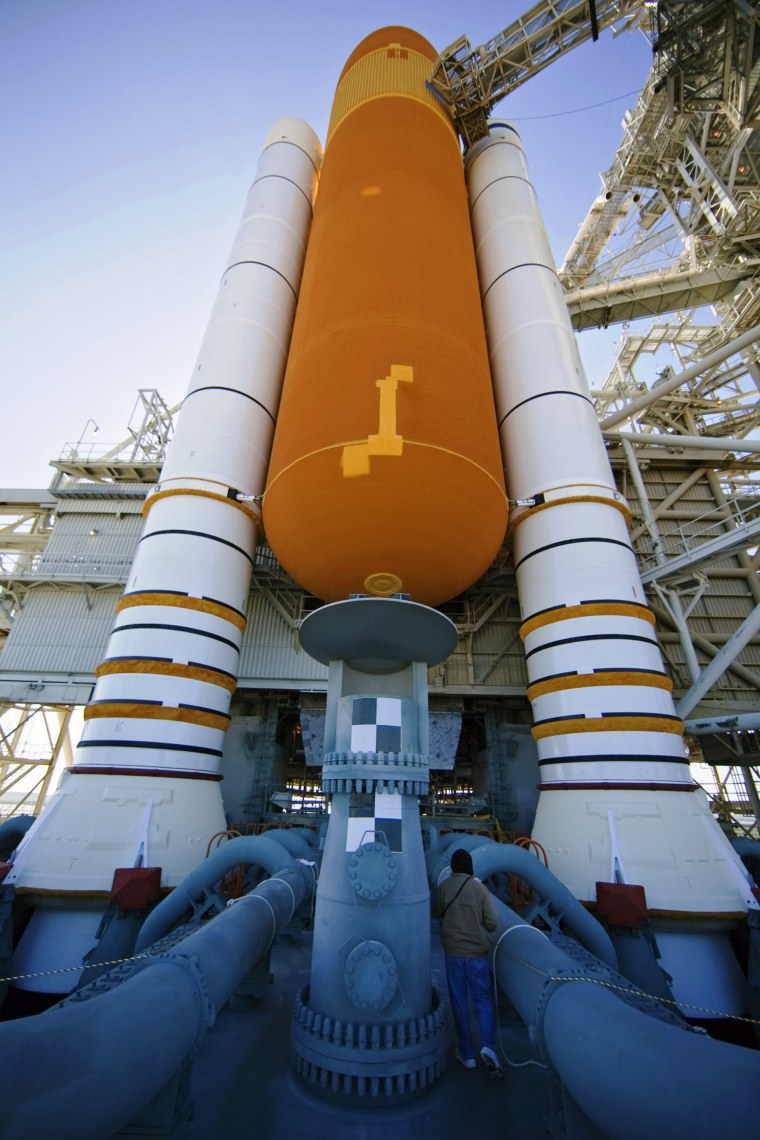The space shuttle Discovery's launch is being taken off the schedule for this month and will occur no earlier than Feb. 3, due to continuing concerns about cracks that were found in the external fuel tank, NASA said Friday.
The cracks that were found around the tank's supporting ribs, or "stringers," have been repaired. However, NASA officials said more tests need to be done to understand the root causes of the cracks — and to ensure that the fuel tank is completely safe for launch.
"The teams have recommended that we step back a little bit and do some testing," Bill Gerstenmaier, NASA's associate administrator for space operations, told reporters at Johnson Space Center in Houston.
Those tests will involve efforts to replicate the problem with mockup tank material, as well as a test that calls for the launch-pad team at Kennedy Space Center in Florida to fill the tank with fuel and monitor the resulting structural stresses with embedded sensors. The pad test would take place by late December.
Space shuttle program manager John Shannon said he had no information indicating that cracks along the stringers posed a problem for past flights, or for future flights. "This is a unique event to us," Shannon said. But so far, engineers have not been able to determine why the cracks cropped up on Discovery's tank — and that's a question they want to answer before Discovery is launched.
Discovery had been scheduled to take on its 39th and final flight on Dec. 17 — a date that already reflected several delays due to bad weather and tank concerns. The shuttle is due to carry up an extra storage room for the International Space Station as well as an experimental humanoid robot called Robonaut 2. Two spacewalks are scheduled during the 11-ay mission.
Gerstenmaier said there wasn't enough time to do the tests and still hit the December launch schedule. The next launch window runs from Feb. 3 to 10, and the window after that lasts from Feb. 27 to March 6. If Discovery is ready to go on Feb. 3, launch time would be 1:34 a.m. ET.
The latest delay means the mission after Discovery's, to be flown on the shuttle Endeavour, has to be shifted to no earlier than April 1, NASA said. Endeavour's main mission is to deliver an international $1.5 billion astrophysics experiment known as the Alpha Magnetic Spectrometer to the space station.
The space agency's third remaining shuttle, Atlantis, is expected to take on yet another space station resupply flight in June if Congress comes through with the money.
The shuttle fleet is due for retirement this year, with either Endeavour's flight or Atlantis' flight representing the final mission of the shuttle's 30-year history. So far, the delays bedeviling Discovery have not affected the overall schedule for the shuttle program's endgame.
"The end time for our last mission really hasn't changed," Shannon said.
Each month of extension in shuttle operations is said to cost $150 million, but Gerstenmaier said, "We haven't really pushed or upset anything from an overall budget standpoint."
After the fleet's retirement, NASA will have to rely on other countries' transports — such as Russia's Soyuz and Progress craft as well as Europe's ATV and Japan's HTV cargo spaceships. An HTV launch is scheduled for January, and leaving room for that mission is one of the reasons why Discovery has to wait until February. Another reason has to do with unfavorable sun angles for shuttle operations at the space station in January.
NASA is also planning to use U.S.-built commercial spaceships for space station resupply. One of those prospective spaceships, the SpaceX Dragon capsule, is due to get its first NASA-supported flight test next week atop a Falcon 9 rocket. On Friday, SpaceX conducted a brief static engine firing test at the Falcon's Florida launch pad.
